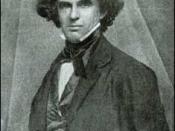Most criticism and reflection of Nathaniel Hawthorne's Young Goodman Brown centers on a good versus evil theme. Critics also debate interpretations of the main character's consciousness; is Brown awake or dreaming. What is certain is that he lives and dies in pain because his belief in his righteousness isolates him from his community. It is also certain that Hawthorne's interpretation of Brown's 'mid-life crisis' has ambiguity and leaves a reader with many different feelings about what and why certain things have happened. Hawthorne's use of symbolism in his allegorical tale Young Goodman Brown causes the main character's revelations about the sin within his community, his family and himself.
Young Goodman Brown's journey into the forest is best defined as a kind of 'general, indeterminate allegory, representing man's irrational drive to leave faith, home, and security temporarily behind, for whatever reason, and take a chance with one(more) errand onto the wilder shores of experience' (Martin).
Brown has a curiosity that 'kills' his naive outlook on life and changes him until his death. He has a mission to go into the forest and meet the devil. A mission that he begins out of curiosity and a 'deep need to see if the teachings of his childhood, his religion, and his culture, have armed him sufficiently to look the devil in the face and return unscathed' (Hodara 1). The symbol of the forest, late at night, can be interpreted as the untamed regions of Brown's heart where the devil roams freely as he roams in the forest. The forest is the devil's domain. Brown finds, in the dark of the night, many of his daytime friends share this domain with the devil. What he considers moral and 'good' in his life he finds in the forest. This torments his perception of practically...
![[Portrait of Juan Tizol(?) and Lawrence Brown(?), Aquarium, New York, N.Y., ca. Nov. 1946] (LOC)](https://s.writework.com/uploads/7/77189/portrait-juan-tizol-and-lawrence-brown-aquarium-new-york-n-thumb.jpg)


Thanks for the help
you have given me a direction for my paper.
4 out of 5 people found this comment useful.